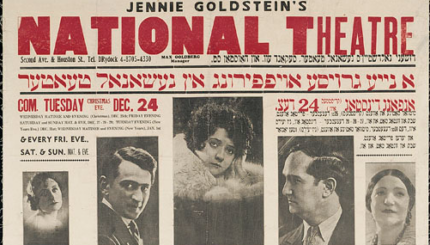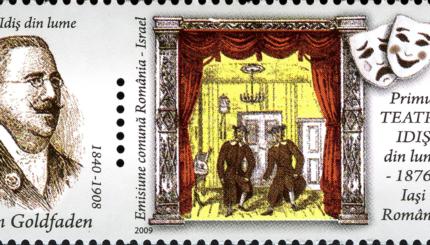Yiddish was once a vibrant language. It was the language of literature and political discourse and also the language of everyday life for the masses of Jews who lived for centuries in Eastern Europe.
The Yiddish films that were produced from the 1920s to the 1940s in Poland and the United States, reflect a wide spectrum of Jewish life–rich and poor, educated and illiterate, traditional and assimilationist. These films capture the atmosphere, concerns, values, and myths of the Yiddish milieu as well as the unique flavor and nuances of the Yiddish mameloshen [mother tongue]. As Jim Hoberman writes in his book Bridge of Light: Yiddish Film Between Two Worlds, “Drawing upon an established dramatic and literary tradition, yet employing a language virtually unknown to the Gentile world, this was not just a national cinema without a nation-state, but a national cinema that, with every presentation, created its own ephemeral nation-state.”
Piety and Superstition
Perhaps the greatest Yiddish film ever produced is Der Dibuk (The Dybbuk, directed by Michael Waszynski), made in 1937 in Poland, before World War II. Based on the classic play by S. Ansky — written during the years of 1912-1917, when he traveled through the Pale of Settlement in Russia — the film documents the rich ethnographic life of the shtetl, the small, mostly Jewish villages of Eastern Europe. Although Ansky never lived to see his play produced, it became the most widely staged production in the history of the Yiddish theater.
Der Dibuk is a dark and melodramatic film with mystical themes that tells the story of young lovers who had been promised to each other. Many years earlier, two yeshivah students made an oath that their children would marry. In the meantime, one has died and the other has forgotten his oath. Now, years later, the daughter is about to marry someone else. But she is meant for another. The most memorable scene of the cinematic version is the haunting dance of the beggars, in which the beautiful yet melancholy bride finds herself dancing with death itself.
Gender Roles
In a completely different style, Yidl mitn Fidl (Yiddle With a Fiddle, directed by Joseph Green and Jan Nowina-Przybylski, 1936), also produced in Poland, is a charming and humorous look at gender roles in the changing world of the shtetl. Starring the Yiddish film superstar Molly Picon as a dissatisfied young woman who dreams of studying Talmud in the man’s yeshiva world, the film showed remarkable sensitivity and depth in exploring the roles of men and women in this milieu.
Another film about female roles, this one produced in the U.S., is Mirele Efros (directed by Joseph Berne, 1939). The main character of the film is Mirele Efros (played by Berta Gersten), the matriarch of a Jewish family who loses her control over the family to her new self-seeking daughter-in-law.
An elaborate, sophisticated production of a stage classic by Jacob Gordin, the film includes a marvelous depiction of a traditional betrothal. Sometimes described as “The Jewish Queen Lear,” this tale pits the values of honesty, decency, and devotion to family against the human tendencies toward passion, weakness, and greed. A melodrama, the film makes a serious comment on women’s roles and on mother-in-law/daughter-in-law relations within the family context.
Drama and Tears
Perhaps the best-known Yiddish film produced in the United States is Tevye der Milkhyker (Tevye the Milkman, 1939), directed by and starring Maurice Schwartz. The film is based on the original stories of Sholem Aleichem and is the precursor to the great Hollywood adaptation of the same stories, Fiddler on the Roof (directed by Norman Jewison, 1971). Often cited as a film about “tradition,” the film is actually about modernity and the decline of the traditional lifestyle, especially symbolized in the marriage of one daughter to a local (non-Jewish) Russian student.
Humor and Pathos
A third U.S. -produced Yiddish film classic is the romantic comedy, Grine Felder (Greenfields, directed by Jacob Ben-Ami and Edgar Ulmer, 1937), which tells the story of a yeshiva bucher [student] who leaves the protected world of the religious academy to go out into the countryside searching for truth and for honest Jews who work the land. The honest labor of the peasant Jews who made their living from the land was a subtext, referring to the Zionist enterprise that was blossoming during the same period. Based on a play by Peretz Hirschbein, the film was a huge box office hit in 1937 New York.
Cantorial Music
An interesting emphasis of a number of Yiddish films is the ambivalent relationship between tradition and modernity as expressed through the lifestyle choices of young cantors. One such film with this premise is Overture to Glory, starring Moishe Oysher as the cantor (U.S., 1940). This subject, however, was not unique to Yiddish films. A similar premise was the basis for an earlier film, produced by Hollywood — the first English-language talkie, The Jazz Singer (1927, directed by Alan Crosland), starring Al Jolson as the cantor who chooses the non-Jewish world of opportunity over the parochialism of the Jewish world.
A Whole World
In these and other Yiddish films, an entire range of the complexity of Yiddish culture (which included more than the poverty and superstition of the shtetl) is portrayed. This involved such salient features of Jewish life as strong family values, the savoring of ancient folkways, rich doses of humor in the face of hardship, and unbreakable ties to tradition.
These Yiddish films, largely based on Yiddish theater, were not made as documents of a dying culture. Rather, they were produced by savvy Jewish businessmen who understood the essentials of commercial filmmaking and whose goal was to entertain Jewish audiences. And these Jewish audiences loved the melodrama and humor of Yiddish stage and cinema.
Though the world of Yiddish film was largely destroyed by the Holocaust and the decline of Yiddish in the United States, it would demean these films to see them purely as nostalgia of a lifestyle that is no more. In addition to helping today’s Jews reflect back on their roots, these films provide insight into the richness of another cultural world.
And some of these films are available to today’s viewers. Films of the early years were produced on flammable nitrate stock and disintegrated as the years passed. A large collection of Yiddish films was preserved and transferred to safety film by the Rutenberg and Everett Yiddish Film Library of the National Center for Jewish Film and is available for contemporary viewers.
Talmud
Pronounced: TALL-mud, Origin: Hebrew, the set of teachings and commentaries on the Torah that form the basis for Jewish law. Comprised of the Mishnah and the Gemara, it contains the opinions of thousands of rabbis from different periods in Jewish history.
shtetl
Pronounced: shTETTull, Origin: Yiddish, a small town or village with a large Jewish population existing in Eastern or Central Europe in the 19th and early-to-mid 20th century.
yeshiva
Pronounced: yuh-SHEE-vuh or yeh-shee-VAH, Origin: Hebrew, a traditional religious school, where students mainly study Jewish texts.
yeshiva bucher
Pronounced: yuh-SHEE-vuh BOOKH-ur (oo as in book), Origin: Yiddish, a young (male) student at a Jewish religious school.


